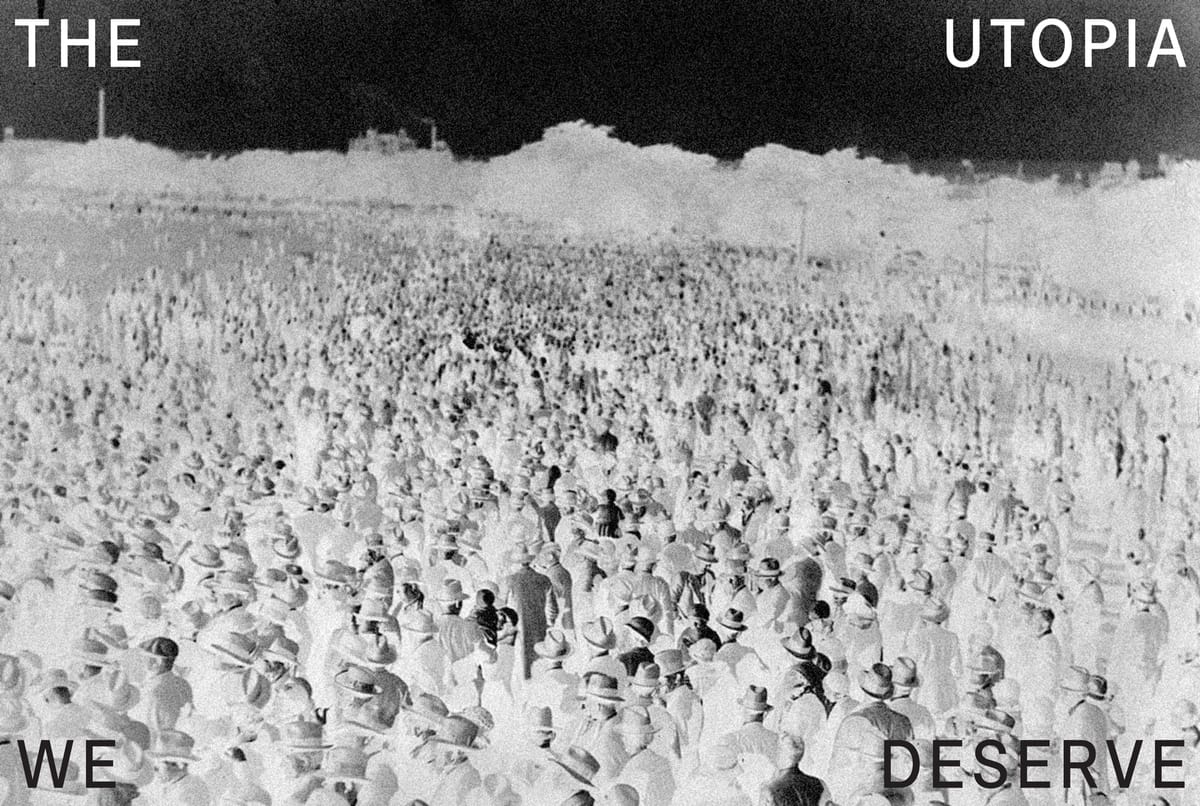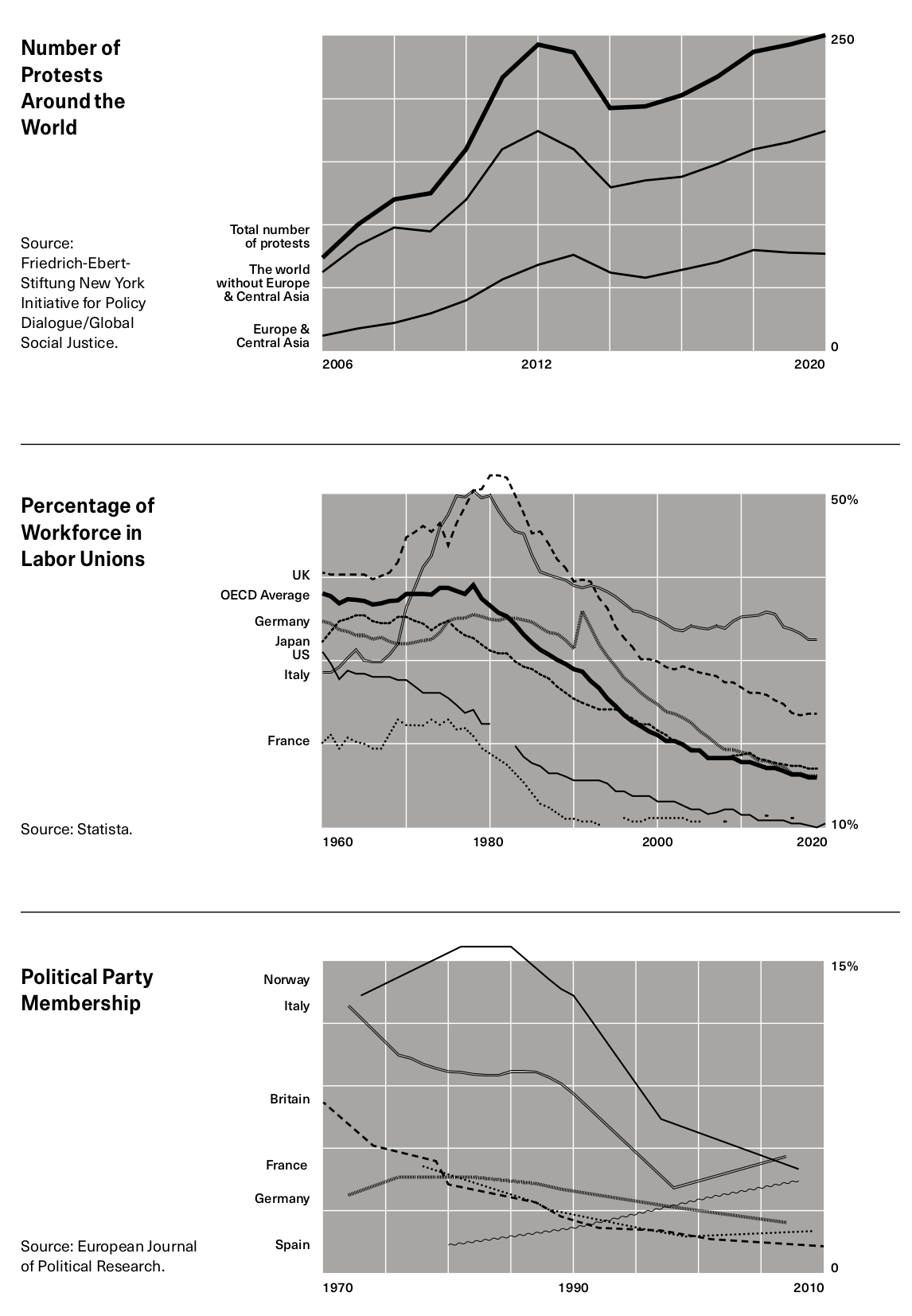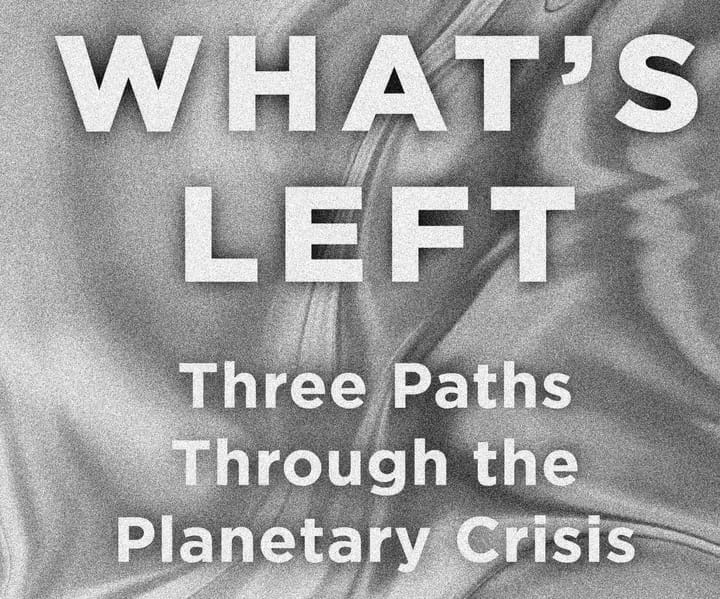The Utopia We Deserve
The anti-utopian utopianism of the early- to mid-twentieth century eschewed flights of fancy for concrete world-building. Now we are stuck between a dystopianism that promises an end and a utopianism that does the same.

In 1891 the Social Democratic Party of Germany (SPD) found itself in a quandary. Having grown into the most powerful social-democratic outfit in Europe, they were facing the increasingly real and scary prospect of power. What would a world in which the socialists were in office look like? In the same year, a German employers’ magazine published an article envisioning a hypothetical future with the SPD in charge: Sozialdemokratische Zukunftsbilder (frei nach Bebel). Wohin führt der Sozialismus? (“Social-Democratic Images of the Future (Freely Based Off Bebel)—Where Does Socialism Lead?”)
Composed by a liberal publicist, the pamphlet was a careful exercise in dystopian futurology. It predicted that a socialist government would usher in a destruction of civil liberties, a siege of the economy, and a mass flight of civilians. Although conceived as a fictional diary of a social democrat who reports on the aftermath of a victorious revolution, the novel ends with the construction of a border wall to prevent citizens from fleeing to neighboring countries—an eerie premonition of what would happen when Germany’s socialists would finally get to build their state after 1945, under Stalinist supervision.
In 1891, of course, SPD politicians were unanimous in their dismissal of the pamphlet. Socialism would look nothing like the clichéd barracks society the piece warned about. Yet neither did they counterpose it with a positive vision that could falsify the original. As in Puritan iconology, the SPD’s utopia could not be depicted; socialism was the terminus of the human journey, yet no one knew exactly what socialism looked like—and did not want to guess, either.
The SPD’s wager was different: socialists had to intensify and work with the trends immanent to capitalist society itself, including the daily struggles of the working class, rather than busy themselves with recipes for the workshops of the future. Utopianism, so the Second International’s guiding argument ran, was the product of a pre- or not-fully-capitalist society. There, a gap between reality and norm was determined by the relatively small surplus the society in question produced. These critics reminded readers of Augustine’s distinction between the City of God (civitas Dei) and the City of Man (civitas hominis): here a finite world of human aspirations, running into the hard limits imposed by the deity, and there a land of plenty placed in the afterlife. By analogy, a precapitalist utopianism only served to cool emancipatory ambitions, putting freedom out of reach in the present and into the socialist afterlife.
The full development of capitalism introduced a change in this calculus. Rather than accepting a separation between “is” and “ought,” Marxism grew immanently out of possibilities generated by capitalist society itself as “the real movement of things.” Suddenly, the present seemed pregnant with possibilities absent before; the gap between now and then could shrink. “Only what is not, is possible,” as German socialists liked say it; or, as Adorno put it, Marx and Engels “were enemies of utopia for the sake of its realization.” Yet it was clear that this pure evasion of utopian imagery was never sufficient. As Adorno himself stated in a letter to Ernst Bloch, the “ban on images” that communist movements practiced could not be maintained indefinitely. “One may not cast a picture of utopia in a positive manner”, he claimed. “the prohibition of casting a picture of utopia [is] actually for the sake of utopia…. [This] has a deep connection to the commandment, ‘Thou shalt not make a graven image!’” Pictures of heaven would distract, and make it more difficult to actually build heaven on earth.
“Yet given this imperative against picturing utopia”, Adorno continued, “there still is some content to utopia: utopia is essentially in the determined negation, in the determined negation of that which merely is, and by concretizing itself as something false, it always points at the same time to what should be.” Before Adorno, Karl Kautsky drew a similar conclusion about agrarian radicals such as Thomas More and Thomas Müntzer. Their ουτοπία stood between a “good place” and the “no place” precisely due to the constraints of underdevelopment, under which the moderns’ anti-utopian utopianism was not yet conceivable. In Kautsky’s era, the gap between what is and what is possible began to shrink: capitalism opened up possibilities for emancipation unavailable before, yet always in the negative, without explicit visions of flourishing.
This anti-utopian utopianism facilitated an agnosticism on policy questions that might feel quaint today. As Engels stated on the question of sex work, “the regulation of sex relationships after the impending effacement of capitalist production is, in the main, of a negative character, limited mostly to what will vanish.” Pre-empting his critics, however, he immediately continued:
What will be added? That will be settled after a new generation has grown up: a generation of men who never in all their lives have had occasion to purchase a woman’s surrender either with money or with any other means of social power, and of women who have never been obliged to surrender to any man out of any consideration other than that of real love, or to refrain from giving themselves to their beloved for fear of the economic consequences. Once such people appear, they will not care a rap about what we today think they should do. They will establish their own practice and their own public opinion, conformable therewith, on the practice of each individual—and that’s the end of it.
Deregulation of the Utopian Impulse
What would it mean to talk of a crisis of utopian thought today? The decline of the type of mass politics associated with the German SPD has not only meant malaise for socialism, but a crisis of utopian thought itself. As Russell Jacoby has put it, “Over the years and against conventional wisdom, utopians sustained a vision of life beyond the market.… The socialist economy was not the goal; it was simply a precondition for humanity to advance to a new and humane culture.” At the cusp of the new millennium, however, “the economic structure of society—call it advanced industrial society or capitalism or the market economy—[stood] as the invariant; few can imagine a different economic project…. The future looks like the present with more options.”—in other words, the “end of utopia.”As Jacoby had to admit, the facts, or new “is”, of the late 1990s confronted socialists with a set of circumstances that it would have been hard for late nineteenth-century socialists to imagine, from deindustrialization to atomization. Socialism once stood for the liberation of sociality implicit in modern capitalism. The “ban on images” or iconoclasm Adorno mentioned could be maintained due to the presence of a social form—the mass party—which itself suspended the utopian question, as Engels made clear.
In the absence of this mass socialist politics, a deregulation of the utopian impulse was all but inevitable. Socialism without the masses, or politics without the social, falls back into a renewed utopianism, driven by a weakened sense that market-dependency can be historically transcended. The rise of the new abolitionism itself pays testimony to this deregulation: rather than abolishing the coercive market relations which both determine and warp the social, the call is to abolish those institutions themselves—be it work, prisons, police, restaurants, family, or sex. The result is a mixture of category confusion and pars pro toto, visible in slogans such as “to get rid of capitalism, we must get rid of x”, “A world without x will be a world without capital”, or “Want to abolish capitalism? Abolish x.”
This approach to social pathology can be analogized to the cognitive-behavioral-therapeutic vision of mental illnesses. Like CBT, abolitionism and hyperpolitics propose an advanced form of symptom treatment: the attempt to efface an object’s representation rather than work through the contours of the object itself. Without the mass opposition to a social problem, only its surface manifestations will elicit attention. The attraction of this method in an age of despair is hardly surprising. As those acquainted with CBT will attest, symptom treatment is much better than no treatment at all; a pathological form of functioning is still “a” form of functioning. Like psychoanalysis, mass politics is patient, expensive, and time-consuming. Today’s abolitionists are, by contrast, on the lookout for cheaper, quicker options.
To Jacoby, the decline of mass politics and the decline of psychoanalysis share affective roots. Here is an autobiographical recollection from Eric Hobsbawm, for instance, from his Interesting Times:
On 25 January 1933 the KPD organized its last legal demonstration, a mass march through the dark hours of Berlin converging on the headquarters of the Party, the Karl Liebknechthaus on the Bülowplatz (now Rosa Luxemburg-Platz), in response to a provocative mass parade of the SA on the same square. I took part in this march, presumably with other comrades from the SSB, although I have no specific memory of them. Next to sex, the activity combining bodily experience and intense emotion to the highest degree is the participation in a mass demonstration at a time of great public exaltation. Unlike sex, which is essentially individual, it is by its nature collective, and unlike the sexual climax, at any rate for men, it can be prolonged for hours. On the other hand, like sex it implies some physical action—marching, chanting slogans, singing—through which the merger of the individual in the mass, which is the essence of the collective experience, finds expression. The occasion has remained unforgettable, although I can recall no details of this demonstration. I can only remember endless hours of marching, or rather alternately shuffling and waiting, in the freezing cold—Berlin winters are hard—between shadowy buildings (and policemen?) along the dark wintry streets. I cannot remember red flags and slogans, but if there were any—and there must have been some—they were lost in the grey mass of the marchers. What I can remember is singing, with intervals of heavy silence. We sang—I still have the tattered pamphlet with the texts of the songs, ticks against my favorites: the ‘Internationale’, the peasant war song ‘Des Geyers schwarzer Haufen’, the sentimental graveyard doggerel of ‘Der kleine Trompeter’, which (I am told) the leader of the GDR, Erich Honecker, wanted played at his funeral, ‘Dem Morgenrot entgegen’, the Soviet Red Airmen’s Song, Hanns Eisler’s ‘Der rote Wedding’, and the slow, solemn, hieratic 'Brüder zur Sonne zur Freiheit’. We belonged together. I returned home to Halensee as if in a trance. When, in British isolation two years later, I reflected on the basis of my communism, this sense of ‘mass ecstasy’ (Massenekstase, for I wrote my diary in German) was one of the five components of it—together with pity for the exploited, the aesthetic appeal of a perfect and comprehensive intellectual system, ‘dialectical materialism’, a little bit of the Blakean vision of the new Jerusalem and a good deal of intellectual anti-philistinism. But in January 1933 I did not analyze my convictions. Five days later Hitler was appointed Chancellor.
As the twentieth century recedes into the distance, its typical forms of political engagement also begin to acquire a clearer contrast with the dynamics of political mobilization in the twenty-first century. Although closely tied to the era of pre-Fordist factory labor, mass politics was hardly exhausted by this industrial workplace and found a locus across modern society, both on left and right. Each form of twentieth- and twenty-first-century politics can also be placed on a grid of socio-economic coordinates. Schematically, mass politics seems to belong to the era of industrial modernity; post-politics pertains to the epoch of deindustrialization and globalization in the 1980s, 1990s, and 2000s; anti-politics to the populist decade and the chaotic management of the 2008 crash; and what has been termed “hyperpolitics” to that of the repoliticized 2010s and 2020s.
From Masses to Classes…
What did the specifically socialist variant of mass politics look like? In 1918, German sociologist Max Weber offered a canonical definition of politics as “slow, strong drilling through hard boards.” Politics took “both passion and a sense of judgment”, in Weber’s view, and “even those who are neither leaders nor heroes must arm themselves with that steadfastness of heart which can brave even the crumbling of all hopes.” In November 1918, his statement was an encrypted critique of the revolutionary impatience of Germany’s communists after the First World War, who sought to emulate their Russian comrades in “painting Germany red.” Weber held his lecture to a group of right-wing students, who were to quash the country’s revolution and secure the propertied order (the German sociologist was far from a communist).
Despite his hostility, however, Weber and his opponents were also children of the same age. Both played parts in a mode of politics consistently more patient, durable, and long-term than the flashy forms familiar to us in the twenty-first century. To Germany’s communists and fascists, everything might have been political, and the personal might have been political too. Yet to them it was hard to reduce the political to the personal, and the totality of politics encompassed a social landscape broader and deeper than the brittle society we currently inhabit. To extend Weber’s metaphor, if mass politics is the slow boring through hard boards, hyperpolitics is cutting through styrofoam.
The durability of mass politics is visible in the etymology of the word “mass” itself: late Middle English: from Old French masse, from Latin massa, from Greek maza “barley cake”; perhaps related to massein “knead”. Raymond Williams’ Keywords gives us an even more expansive vision, and shows how the specifically “social” and not physical understanding of masses began to turn with modernity:
Mass had been widely used, in a range of meanings, from C15, from fw masse, F and massa, L - a body of material that can be molded or cast (the root sense was probably of kneading dough) and by extension any large body of material. Two significant but alternative senses can be seen developing: (i) something amorphous and indistinguishable; (ii) a dense aggregate.... A sense of the relation of the term to the INDUSTRIAL REVOLUTION (qq.v.) appears to be evident in Gaskell’s ‘the steam engine has drawn together the population into dense masses’ (The Manufacturing Population of England, 6; 1833).
To Williams, a double connotation with both difference and repetition is crucial to the notion of a “mass.” Masses are unorganized and indistinct, yet with enough steering and agency they can be turned into an active agent. The notion of the “massing” or “forming” by a demiurge indicated this: God took a “mass” of clay and turned it into a human. In the same way, the modern world, and particularly the factory, had created a mass with a certain weight which was indistinct but could be made distinct. The mass was different from the multitude in that multitudes were larger and swarming (as Hobbes said it), but they could not become a “common agent.” Hence there was an intrinsic imperative for organization or representation implicit in the notion of the mass: it needed to be kneaded and shaped, collectively.
What was specific about the left vision of mass politics, then? First, their structures were more egalitarian and open to participation, and less hierarchical. But their vision obviously also had a finality built into it. Conservative mass politics sought to secure affiliation, but it was mobilized mainly for preservation and stabilization, not upheaval. Even in the fascist version of mass politics, the idea was to disguise a counter-revolution as a revolution: to unleash a civil war on the labor movement. This is visible in how Marx and Engels regard the term. Although British bourgeois liberals sometimes liked to summarize their project as opposing “masses versus classes,” they nonetheless saw the working masses as the central subject with which a socialist mass politics had to work (think of the Greek “Massein,” or the party as the “masseur” of the masses). For the left, on the other hand, the point was to turn masses into classes, which implied a specific configuration between the social and political: a combination of affiliation and mobilization, or socialization and politicization. Workers had to be mobilized for voting campaigns or other goals, but they also had to be inserted into larger organizational bodies in which they would create long-term bonds. Hence the intrinsic long-termism, as Weber put it, or the patience that came with mass politics since the late nineteenth century.
Two factors seem crucial here. The first is the clear predominance of industrial labor, and the industrial mode of work that came with it. As Marx saw, factories grouped and literally “massed” workers together in large economic units. In this setting, industrial labor was an intrinsically social and therefore interdependent form of labor; there was no sense in which laborers could pretend to make an individual effort. Rather, many industrial processes required constant vigilance and forced co-operation on workers, often in a brutal way. Before Fordism and other innovations in management, the main model of supervision was the military: the manager as a commander disciplining an army. Here was the “mass” material that socialists could then mold in their own direction; not the swarm or the Marxian sack of potatoes familiar from a time before or after mass politics, but a cohesive social object which could become a corporate body. The masses of the industrial era also came with specific geographical patterns. Industrialization in the late nineteenth century, although stimulated by developments in the countryside, was still a predominantly urban phenomenon. This meant that workers were segregated together in neighborhoods. The “mass” might have been a vague entity, but sociologically mass politics relied on a form of mass housing where workers were not residentially separated from each other.
The second crucial factor is the preponderance of a specific mode of sociality in the nineteenth century—religiosity. All through the arc of mass politics from the late nineteenth century until the 1980s, socialists confronted a society in which the main mode of sociability was still religious. This of course had an ideological dimension, but it also had sociological implications: the Church was a densely organized, seemingly organic institution which inserted individuals into corporate collectivities. Particularly in countries where the ancien regime was strong, the main mass institutions on the Right were churchly ones (it is unsurprising that notions of orthodoxy, heterodoxy, and sects are so widespread across socialist history). Take, for instance, this passage from Gaspar Tamas, which demonstrates this opposition and denotes the long-term commitment implicit in mass politics:
A Hungarian sociological survey from 1906 shows that a working-class housing estate in Transylvania has one portrait of Marx and one of Lassalle per flat, workers are teetotal in a heavily drinking society, and open atheists and anticlericalists in a polity dominated by the church militant; church weddings are frowned upon, there are attempts at a healthy diet, non-competitive sports (not shared with outsiders) are encouraged (in Central Europe there were special socialist workers’ athletic championships and mass musical choir contests until 1945); non-socialist charities are rejected, parties are held only in daylight to avoid immorality, and at least the men are trying—in a country of barefoot illiterates one generation away from the village primeval—to read social science and serious history. Admirable as this is, it must have been, for all intents and purposes, a sect.
…and Back
In the last couple decades, both of these factors—industrial labor and the Church—have steadily shrunk in the developed and developing world. This went hand in hand with geographical changes in the structure of working life. Suburbanization and the extension of suffrage dispersed the proletariat out of the urban centers that had been the mainstay of nineteenth-century socialist politics. As Vivek Chibber notes, “the physical layout of large industrial centers pushed workers together into crowded spaces, while separating them from their employers.” By the 1960s, this was no longer a certainty. “The flight of industry from urban centers, followed by the migration of securely employed working-class families to the suburbs, had a profound effect on class identities”—making suburbia more amenable to the “sack of potatoes” Marx described. As Hobsbawm noted, “urban development, public and private, was destroying the very bases which had allowed the formation of [the] ‘urban villages’ on which so much of labor strength had rested.... The effect of all this on labor movements in the great city [was] to deprive them of their former cohesion.”
What happens to socialist politics under these circumstances? Alternatively, what would a vision of socialist politics “without” the masses look like? Except for some trained activists and non-profit professionals, the participants in the 2020 BLM protests quickly went back to their day jobs with little mark of their participation, save for the black squares that adorned their Instagram profiles. Unlike the 1963 March on Washington—where marchers came wearing jackets adorned with their union buttons and civic labels—most of the George Floyd protesters shared no prior affiliation, membership lists, or institutional cadre, with only a few, foggily-funded NGOs as stewards. Perhaps this is why, despite being targeted by the largest protests in American history, virtually all the police department budget cuts in late 2020 were reversed soon after.
Such ephemeralization is not limited to the Left. On the Right, too, “movements” from the Tea Party to Trumpism to QAnon rise, proliferate, and disperse with unnerving rapidity. They come and go, like a neutron bomb that shakes the people in the frame but leaves all the infrastructure intact—an awkward synonym rather than an antonym to post-politics. There are, of course, some immediate differences between the two: Hobsbawm participated in a demonstration which numerically might have been smaller than the 2020 protests. But the modes of belonging that motivated his participation were also different. Hence the peculiar combination of politicization and socialization: not only excited subjects, but also people who were not lonely.
The 2020s exhibits, by contrast, a repoliticization without resocialization. No hard mathematical proof can be proffered for the new hyperpolitical predicament, yet a few graphs suffice to illustrate the crossing between loneliness and excitation, atomization and enthusiasm. Take, for instance, the following data documenting party and union membership and protest activity in the last twenty years.

Leaving aside some minor exceptions, the graphs in question display a world increasingly subject to protest and polarization. Yet it also is a world not taken with the modes of durable, patient collective action recurrent throughout the late-nineteenth and twentieth century. While protest activity increased across the 2010s and 2020s, and online media were swamped with political commentary, party membership, unionization, and strike frequency continued their age-old, stubborn decline. Indeed, the two curves seem to share a negative correlation, with the mood of protest coinciding with a continued fall in civic engagement.
Socialization and politicization once made anti-utopian utopianism plausible, one that eschewed flights of fancy and involved building a concretely better world through the mass reduction of market dependency. The removal of these factors greatly dislocated the parameters of what socialism’s utopia looked like. In its wake, we get a manic-depressive alternation between a generalized apocalypticism and political programs centering the abolition of existing structures rather than their reformation, or the creation of new ones. “Abolish” is both a nightmare and a dream (every nightmare is, first and foremost, a dream)—oscillating between “is” and “ought,” like a peasant who sees the City of God in their sleep only to return to the fields after waking.
■
Anton Jäger now thinks the situation is serious but not hopeless.



